Top 10 Most Iconic People of the Middle Ages
The period of European history extending from about 500 to 1400-1500 CE is traditionally known as the Middle Ages, starting from the collapse of the Roman civilization in the 5th century CE to the period of the Renaissance. During the Middle Ages, many people left a lasting impact on the world and left their mark, so much so that we still talk about them to this day. Here is a list of the most iconic people who lived in this time period.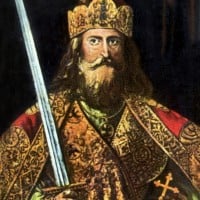
Charlemagne, or Charles the Great, was a member of the Carolingian Dynasty, King of the Franks from 768, King of the Lombards from 774, and the first Holy Roman Emperor from 800 until his death in 814. He is considered to have been a strong leader, a good administrator and is known for many things. Firstly he united most of Western Europe for the first time since the collapse of the Roman Empire, which earned him the nickname of the "Father of Europe". On top of that, he was the first Emperor of the Holy Roman Emperor and played a vital role in the spread of Christianity across Europe. He also believed education was very important and ordered the creation of many schools. Charlemagne is essentially the reason why you get an education today.
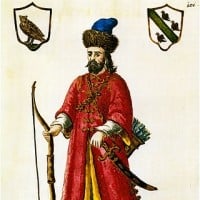 Marco Polo was an Venetian merchant traveller and citizen of the Venice Republic whose travels are recorded in Livres des merveilles du monde (Book of the Marvels of the World, also known as The Travels of Marco Polo).
Marco Polo was an Venetian merchant traveller and citizen of the Venice Republic whose travels are recorded in Livres des merveilles du monde (Book of the Marvels of the World, also known as The Travels of Marco Polo). Marco Emilio Polo was a Venetian merchant, explorer, and writer who travelled through Asia along the Silk Road between 1271 and 1295, 17 of those years he spent in China. Though not the first European to explore China, he became famous for his travels thanks to a popular book he co-authored while languishing in a Genoese prison. Marco Polo is also given a lot of credit for opening up trade routes to East India and China.
Marco Polo helped connect China and Europe by writing a book that contained legends, stories, and facts about his travels.
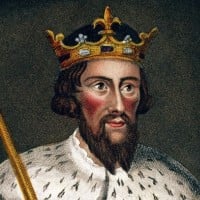
Alfred the Great was King of the West Saxons from 871 to c. 886 and King of the Anglo-Saxons from c. 886 until his death in 899. He was known as a brave, resourceful, pious man, who was generous to the church and anxious to rule his people justly. He is considered to be one of the most famous Anglo-Saxon kings of England and for good reason as despite overwhelming odds he successfully defended his kingdom, Wessex, against the Vikings.
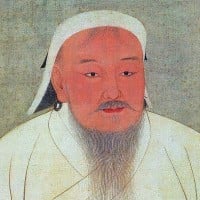 Genghis Khan c. 1162 – August 18 1227, born Temüjin, was the founder and Great Khan of the Mongol Empire, which became the largest contiguous empire in history after his death.
Genghis Khan c. 1162 – August 18 1227, born Temüjin, was the founder and Great Khan of the Mongol Empire, which became the largest contiguous empire in history after his death. Genghis Khan was a Mongol warlord who conquered a large amount of East Asia and created an empire larger than Rome in half the time.
Genghis Khan, born Temüjin, was the founder and first Great Khan of the Mongol Empire, which became the largest contiguous empire in history after his death, spanning the entire Asian continent from the Pacific Ocean to modern-day Hungary in Europe. His massive empire was able to challenge the powerful Jin dynasty in China.
He has $120,000,000,000,000 worth of money. He was born in 1162 near Lake Baikal. He had conquered 9.27 million square miles of land, and his empire stretched through Central Asia, Aral Sea, Caspian Sea, Iran, Caucasus, Eastern Europe, and east of Turkey. He died in Xingqing prefecture on August 25th, 1227, because of his health not recovering. His empire collapsed into 3 empires and 1 nation. His burial place named Burkhan Khaldun is hidden in the peak of Khentii mountains. The statue of him was built in 2008 in Nalaikh, Mongolia.
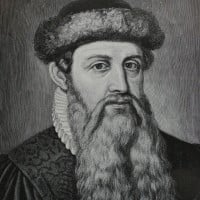 Johannes Gensfleisch zur Laden zum Gutenberg (c. 1398 – February 3, 1468) was a German blacksmith, goldsmith, printer, and publisher who introduced printing to Europe... read more
Johannes Gensfleisch zur Laden zum Gutenberg (c. 1398 – February 3, 1468) was a German blacksmith, goldsmith, printer, and publisher who introduced printing to Europe... read more Johannes Gutenberg is famous for having designed and built the first printing press. His greatest accomplishment was the first print run of the Bible in Latin which took three years to print around 200 copies, which at the time was considered a miraculously fast achievement considering books had to be copied by hand. Although he didn't get to see the impact his invention had on the world at the time, the success of his invention meant that books soon became cheaper, and ever wider parts of the population could afford them.
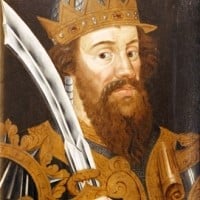 William I, usually known as William the Conqueror and sometimes William the Bastard, was the first Norman King of England, reigning from 1066 until his death in 1087. The descendant of Viking raiders, he had been Duke of Normandy since 1035. After a long struggle to establish his power, by 1060 his... read more
William I, usually known as William the Conqueror and sometimes William the Bastard, was the first Norman King of England, reigning from 1066 until his death in 1087. The descendant of Viking raiders, he had been Duke of Normandy since 1035. After a long struggle to establish his power, by 1060 his... read more Before he became the king of England, William I was one of the mightiest nobles in France as the duke of Normandy, but he is best remembered for leading the Norman Conquest of England in 1066, which changed the course of English history and earned him the name William the Conqueror. He was the first Norman king of England, reigning from 1066 until his death in 1087 and was a descendant of the Viking chieftain Rollo, who was the first ruler of Normandy in France.
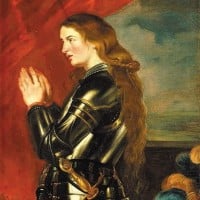 Joan of Arc, nicknamed "The Maid of Orléans", is considered a heroine of France for her role during the Lancastrian phase of the Hundred Years' War, and was canonized as a Roman Catholic saint... read more
Joan of Arc, nicknamed "The Maid of Orléans", is considered a heroine of France for her role during the Lancastrian phase of the Hundred Years' War, and was canonized as a Roman Catholic saint... read more Joan of Arc is considered a heroine of France. She was a peasant girl who, believing that she was acting under divine guidance, led the French army in a momentous victory at Orléans in 1429 that repulsed an English attempt to conquer France during the Hundred Years' War. She is also famous for her tragic death as after she was captured and exchanged to the English, She was put on trial by the pro-English bishop, Pierre Cauchon, on a charge of heresy. She was declared guilty and burned at the stake on 30 May 1431, dying at about 19 years of age. In 1456, Pope Callixtus III authorized an inquisitorial court to investigate the original trial. The court nullified the trial's verdict, declaring it was tainted by deceit, and Joan was exonerated. She was canonized in 1920, and declared a secondary patron saint of France in 1922.
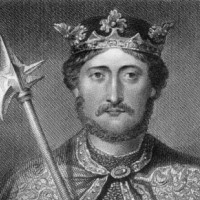
Richard I was King of England from 1189 until his death in 1199. He is remembered for being a chivalrous medieval king, for battling Saladin during the Crusades, and for rebelling against his father, Henry II. He was considered a hero in his day and has often been portrayed as one in works of literature. He is also famous for his capture and imprisonment which happened during his return from the crusade. Bad weather drove him ashore near Venice and he was imprisoned by Duke Leopold of Austria before being handed over to the German emperor Henry VI, who ransomed him for the huge sum of 150,000 marks. In February 1194, the ransom was payed and Richard was released.
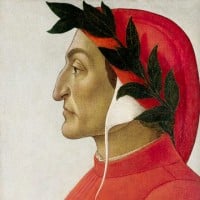 Durante degli Alighieri, simply called Dante (c. 1265 – 1321), was a major Italian poet of the Late Middle Ages. His Divine Comedy is widely considered the greatest literary work composed in the Italian language and a masterpiece of world literature.
Durante degli Alighieri, simply called Dante (c. 1265 – 1321), was a major Italian poet of the Late Middle Ages. His Divine Comedy is widely considered the greatest literary work composed in the Italian language and a masterpiece of world literature.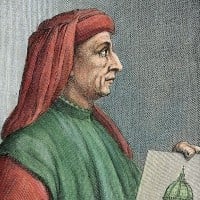
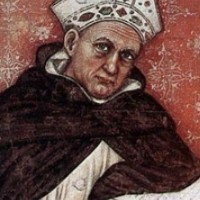
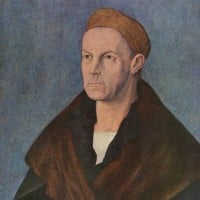
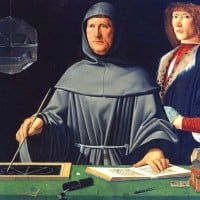
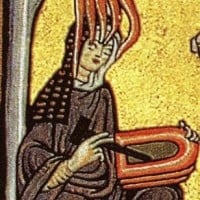
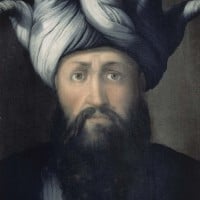
Saladin was a Sunni Muslim Arab who became the first sultan of both Egypt and Syria, and was the founder of the Ayyubid dynasty. Saladin led the Muslim military campaign against the Crusader states in the Levant. Saladin's army was defeated during the crusades by Richard the Lionheart. It is said that the two men's relationship had been one of chivalrous mutual respect as well as military rivalry.
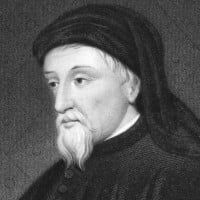 Geoffrey Chaucer (c. 1343 – 25 October 1400), known as the Father of English literature, is widely considered the greatest English poet of the Middle Ages and was the first poet to be buried in Poets' Corner of Westminster Abbey.
Geoffrey Chaucer (c. 1343 – 25 October 1400), known as the Father of English literature, is widely considered the greatest English poet of the Middle Ages and was the first poet to be buried in Poets' Corner of Westminster Abbey. Geoffrey Chaucer was an English poet, author, and civil servant best known for works such as The Parlement of Foules, Troilus and Criseyde, and The Canterbury Tales. He has been called the "father of English literature" because he was the first to write what became generally well-known and recognized poems and stories in the language of the common people of his time, medieval English.
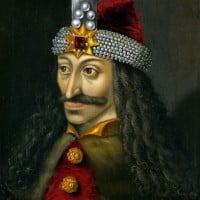 Vlad III (Known as "Vlad the Impaler" or "Vlad Dracula", born 1431) was a Romanian monarch. He was the ruler of Wallachia a total of three times before his death in 1476/7. He is most famous for his reputation as a dictator and his gruesome torture methods and executions, in which he has served as an... read more
Vlad III (Known as "Vlad the Impaler" or "Vlad Dracula", born 1431) was a Romanian monarch. He was the ruler of Wallachia a total of three times before his death in 1476/7. He is most famous for his reputation as a dictator and his gruesome torture methods and executions, in which he has served as an... read more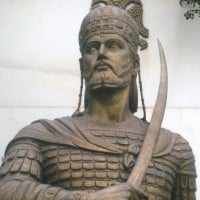
The last Roman emperor (the Byzantine Empire was the eastern half of the Roman Empire). The Roman "Empire" had shrunk so much that by this point it was nothing more than just A) the Roman capital of Constantinople, B) much of the Peloponnese, C) and a few scattered small islands. After rallying the army and people to defend the city against the Ottoman Turks, Constantine XI died while fighting the Turks after Sultan Mehmed II's forces had breached the city walls.
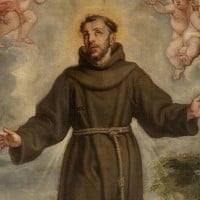
Francis is one of the most esteemed religious figures in Roman Catholic history. He founded the Franciscan orders, including the Poor Clares and the lay Third Order. He and St. Catherine of Siena are the patron saints of Italy, and he is also the patron saint of ecology and of animals.
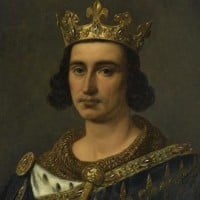
Louis IX, commonly known as Saint Louis or Louis the Saint, was King of France from 1226 to 1270, and the most illustrious of the Direct Capetians. He was crowned in Reims at the age of 12, following the death of his father Louis VIII. His charity was as widely known as his sense of justice, for he founded abbeys, convents, hospitals, and almshouses for the poor. Considered one of the greatest French kings, he consolidated the Crown's control over the great lords and went on two crusades.
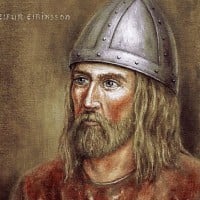 Leif Erikson or Leif Ericson was a Norse explorer from Iceland. He was the first known European to have set foot on continental North America, before Christopher Columbus.
Leif Erikson or Leif Ericson was a Norse explorer from Iceland. He was the first known European to have set foot on continental North America, before Christopher Columbus. Leif Erikson was the son of Erik the Red and a Norse explorer from Iceland. He is believed to have been the first European to have set foot on continental North America, approximately half a millennium before Christopher Columbus.
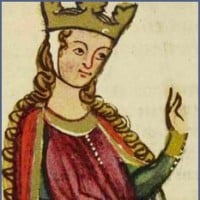
Eleanor of Aquitaine was Queen of France from 1137 to 1152 as the wife of King Louis VII, Queen of England from 1154 to 1189 as the wife of King Henry II, and Duchess of Aquitaine from 1137 until her death in 1204. She was one of the most powerful and influential figures of the Middle Ages. Inheriting a vast estate at the age of 15 also made her the most sought-after bride of her generation.
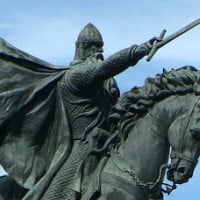
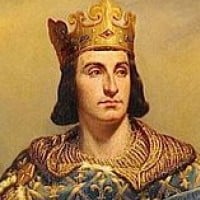
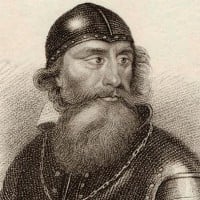
Robert I, also known as Robert the Bruce, who was king of Scotland from 1306 to 1329, freed Scotland from English rule by winning the decisive Battle of Bannockburn and achieving English agreement to full Scottish independence in the 1328 Treaty of Northampton.